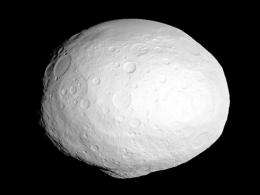This image shows a model of the protoplanet Vesta, using scientists' best guess to date of what the surface of the protoplanet might look like. It was created as part of an exercise for NASA's Dawn mission involving mission planners at NASA's Jet Propulsion Laboratory and science team members at the Planetary Science Institute in Tuscon, Ariz. Credit: NASA/JPL-Caltech/UCLA/PSI
A space mission will soon visit an unusual asteroid called Vesta that may turn out to not be an asteroid at all, but a minor planet.
You've heard of Pluto, once a full-scale planet that astronomers now classify as a dwarf planet. Now meet 4 Vesta -- or Vesta for short -- an asteroid that may not be a real asteroid.
The 330-mile diameter object sits in the asteroid belt, a collection of large and small pieces of rubble that circles the sun between the orbits of the planets Mars and Jupiter. But Vesta, numbered 4 because it was the fourth member of the asteroid belt to be discovered, is larger than most of its asteroid companions and also differs from them geologically.
An unmanned NASA spacecraft called Dawn is now heading for Vesta to explore those differences.
"There are at least two classes of objects that have been called asteroids," said Thomas McCord, director of the Bear Fight Institute in Winthrop, Washington. "The real asteroids are broken up pieces of rock 100 kilometers (62 miles) in diameter or smaller. The others are more like small planets."
In addition to Vesta those others include Ceres, the largest asteroid and first to be discovered, and Pallas, the second asteroid to be spotted. Ceres is now classified as a dwarf planet like Pluto.
However, Vesta is unique in several respects. It is denser than Ceres and Pallas. It also appears to be differentiated into a rocky surface and an iron core, like the terrestrial planets Earth, Mars, and Venus. And it is continually shedding material from its surface as a result of collisions with small asteroids.
"There are little pieces of Vesta all over the asteroid belt," said Tim Spahr, director of the Minor Planet Center at the Harvard-Smithsonian Center for Astrophysics in Cambridge, Mass.
Astronomers have already had a close-up view of some of those pieces because some of them have landed on the Earth's surface as meteorites. Scientists recognized their provenance by studying their spectra, which indicates their chemical composition, and comparing them with Vesta's spectrum.
Ceres and Pallas, which differ from Vesta geologically, shed less debris. "Whatever they are made of doesn’t travel well," said Christopher Russell, professor of geology at the University of California, Los Angeles.
Telescope observations by McCord in 1972 revealed that Vesta’s surface consists of a rock called basalt, which on Earth is made from cooled magma.
"The basalt would make it unique in that category of objects," Spahr said.
"We think of it as a very large asteroid that is very Earthlike -- called Vesta, the smallest terrestrial planet," Russell said.
Astronomers believe that Earth and similar planets formed when a series of small bodies coalesced. "We think that these bodies were around in large numbers and came together to build planets," Russell explained.
McCord added that the problem with Vesta is that "it didn't find a companion to become a piece of a bigger object that would coalesce with other companions." So it remained by itself, a kind of time capsule from an early era in our solar system.
Russell oversees the Dawn mission with McCord as a co-investigator. Dawn is scheduled to reach Vesta in July and spend a year in orbit, using an infrared spectrometer, a camera, and a gamma ray detector to explore Vesta's composition.
The team expects to determine whether basalt uniformly covers Vesta's surface and where on the surface meteorites originate. The mission will also probe a large crater in Vesta's southern hemisphere that has exposed its interior.
"If it is really differentiated, we would see minerals at depths similar to what we see in the Earth’s mantle," McCord said.
When it leaves Vesta, the Dawn mission will travel to Ceres, which is larger, rounder, and wetter than Vesta.
By studying the contrasts between the two objects, astronomers hope to obtain clues to the ways in which the terrestrial planets evolved.
"We're going to try to understand what the building blocks of the early solar system were like," Russell said. "It's really about tracing our family tree and understanding where we come from."
Will the findings lead astronomers to reclassify Vesta? Probably not. At the same 2006 meeting where Pluto was demoted to minor planet status, Vesta was designated one of 269,644 minor planets.
"It was given minor planet number 4, and nobody has worried about [its classification] since," Spahr said.
Provided by Inside Science News Service























